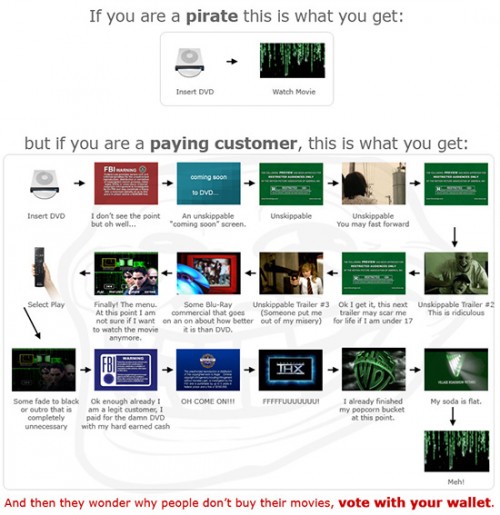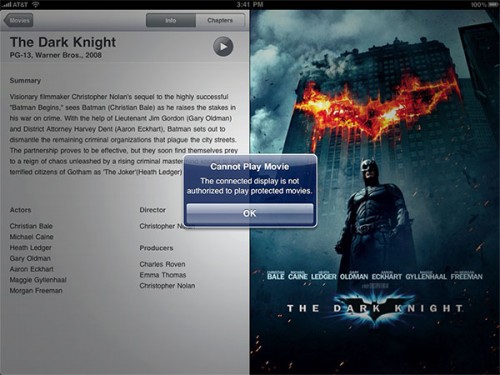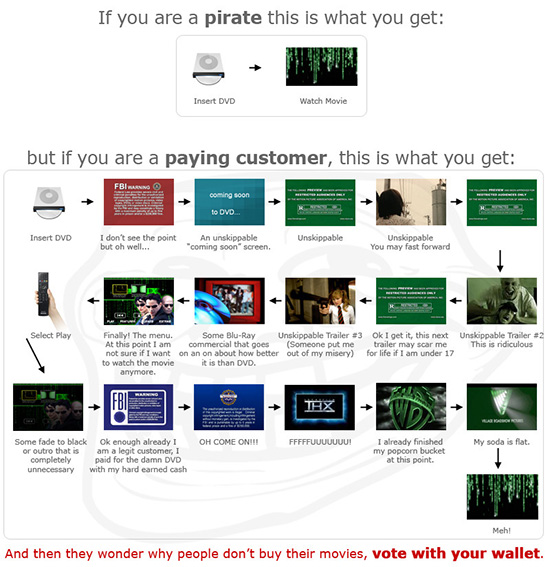(aka The Movie Studios Still Don’t Get It)

I’ve been trying to develop a plan at our house for the past few years to simplify our media content and move to an entirely digital media library.
Ultimately, my dream solution would be a one stop storage device on our network that contains all our photos, music and video and is accessible on either TV in our house as well as on our mobile devices (laptops, tablets, phones etc.)
When Laurie and I first married we had over 100 DVDs and easily twice that many CDs.
We’ve since whittled that down to 30 or so DVDs and fewer CDs – selling most of them to a resell shop.
Along the way we’ve also moved away from buying more physical media content and renting any movies we want to see and buying digital music from iTunes and Amazon. It just doesn’t make sense anymore to keep buying movies we only watch a few times when it’s just as easy to rent the movies for a couple bucks a pop.
Over the last year or so we’ve also opted for renting the vast majority of movies from iTunes instead of running to our local RedBox.
With our new practices in place, we’ve realized a few annoying things related to movies. The movies play fine on our laptops but HD movies have always been blocked if we try to connect our laptops to our TVs via a VGA connection.
It’s been a super annoyance but we’ve stuck to renting standard definition movies and it’s been no big deal (neither of our laptops have standard HDMI outputs and we haven’t felt the need to invest in adapters).
A couple months ago, the new Apple TV was released and I went the same day and purchased one. The idea of wirelessly streaming media from our iPads, iPhones and laptops easily sealed the deal – also knowing I could bypass the HD issue and move our DVD player out and away from toddler hands was another big plus.
Unfortunately, a few hours in I realized the Apple TV wasn’t going to solve our problems. With our horrible Wifi modem (AT&T Uverse) none of the video content played without continually buffering. So despite my high hopes – I returned it.
Recently, I purchased an iPad to VGA adapter for a presentation I had at work. The adapter worked great. Plugged it into the iPad, connected to the projector and presto – my iPad was mirrored to the projector.
At home we played around with the adapter and iPad on our flat screen TV and it easily mirrored our photos, videos, games and several TV shows we had purchased from iTunes. It wasn’t wireless like the Apple TV – but not a bad solution.
Fast forward a week or so and we decided to rent another movie from iTunes. Knowing we had the VGA adapter – rather than pulling our our laptops and downloading the movie there – we simply downloaded the movie to one of our iPads (making sure we had the SD version to avoid trouble with the HD versions).
An hour or two later, the boys were in bed and we set down to watch our movie. With no luck!
Five seconds into the movie, the playback stops and we’re given a warning message that the movie will not play on the connected device.

After a little digging I found this:
From http://support.apple.com/kb/ht4108
HDCP requirements
iTunes Store movies (SD and HD) and TV shows (HD) require an HDCP digital connection such as the one provided when using the Apple Digital AV Adapter and HDMI cable. If you attempt to play this content using a non-HDCP digital connection, such as the Apple VGA Adapter, an alert will appear to let you know that an HDCP-compatible device is required. To view iTunes Store content using a non-HDCP digital connection, do one of the following:Sync the SD version of the TV show
Use an Apple Component AV cable to play the HD version at 480p
Use an Apple Composite AV cable to play the HD version at 480i
Attempting to play rental content on a device that requires an HDCP digital connection may start the rental timer. Use one of the recommended Apple AV cables to view your rental before the time limit expires.
So despite paying $30 for the VGA adapter and despite renting the movie legally from iTunes and despite renting the SD version… we’re out of luck when it comes to viewing this video on our flat screen TV – unless we want to pay $40 for an HDMI cable.
Many are blaming Apple for selling the VGA adapter in the first place but I think the bulk of the blame falls on the movie studios. They’re the ones who are pushing HDMI – not because of the higher resolution – but because it enables a higher level of digital protection of their content (HDCP).
HDCP is an Intel invention and manufacturers pay a licensing fee to Intel to use their technology. The technology is being used all over – including Blu-Ray players and digital satellite receivers.
The studio’s overreaching effort to protect their content started way back in 1980s with VCRs. It’s since moved into the digital realm with Protect IP and SOPA legislation and more.
The fact that they can’t seem to come up with a feasible solution for allowing the end user to watch their movies (or listen to their music) wherever they want, without jumping through major hoops is a HUGE problem and just another example of how they’re still don’t get it – and folks wanting to legally view their content are left banging our heads on the counter.
